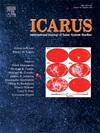相位和颜色比例技术应用于黎明号拍摄的矮行星谷神星和小行星灶神星的照片
IF 2.5
2区 物理与天体物理
Q2 ASTRONOMY & ASTROPHYSICS
引用次数: 0
摘要
在无大气的太阳系天体上识别风化结构异常作为地表变化的一个重要指标。利用相位比法,可以绘制相曲线斜率,并区分出不同风化层光学粗糙度的区域。这些地区是由地形坡度过程、新陨石坑的形成和内生过程的可能影响造成的。高海拔测绘轨道(High Altitude mapping Orbit, HAMO)和低海拔测绘轨道(Low Altitude mapping Orbit, LAMO)对小行星灶神星(Vesta)和矮行星谷神星(Ceres)的全球测绘为相位比技术在这些天体上的应用提供了必要的数据。利用黎明分幅相机(FC)拍摄的矮行星谷神星和小行星灶神星(4)的多光谱图像,对灶神星(Laelia, Laeta, Aricia, Vibidia)和谷神星(Ahuna Mons,陨石坑ocator, Oxo, xevoso)表面的选定区域应用相位比和颜色比方法。相位比方法为谷神星和灶神星这两个天体提供了一个很好的工具,可以检测由于陨石坑壁和山坡上的斜坡过程导致的质量运动相关的风化层结构变化,以及最年轻陨石坑的喷出物。本文章由计算机程序翻译,如有差异,请以英文原文为准。
The phase- and color-ratio techniques as applied to Dawn images of the dwarf planet Ceres and asteroid (4) Vesta
Identification of regolith structure anomalies on atmosphereless Solar System bodies is important as an indicator of the surface changes. With the phase ratio method, we are able to map phase curve slopes and distinguish the areas with different regolith optical roughness. These areas are caused by topographic slope processes, formation of new craters and the possible effects of endogenous processes. Global mapping of asteroid (4) Vesta and the dwarf planet Ceres from two orbits High Altitude Mapping Orbit (HAMO) and Low Altitude Mapping Orbit (LAMO) provide the necessary data for applying the phase-ratio technique to these bodies. Using multispectral images from the Dawn Framing Camera (FC) for the dwarf planet Ceres and the asteroid (4) Vesta, phase-ratio and color-ratio methods were applied for selected areas on surfaces of Vesta (Laelia, Laeta, Aricia, Vibidia) and Ceres (Ahuna Mons, craters Occator, Oxo, Xevioso). The phase-ratio method gives us a good tool for both bodies, Ceres and Vesta, to detect changes in regolith structure associated with mass movement due to slope processes on crater walls and hillsides, as well as with ejecta from the youngest craters.
求助全文
通过发布文献求助,成功后即可免费获取论文全文。
去求助
来源期刊

Icarus
地学天文-天文与天体物理
CiteScore
6.30
自引率
18.80%
发文量
356
审稿时长
2-4 weeks
期刊介绍:
Icarus is devoted to the publication of original contributions in the field of Solar System studies. Manuscripts reporting the results of new research - observational, experimental, or theoretical - concerning the astronomy, geology, meteorology, physics, chemistry, biology, and other scientific aspects of our Solar System or extrasolar systems are welcome. The journal generally does not publish papers devoted exclusively to the Sun, the Earth, celestial mechanics, meteoritics, or astrophysics. Icarus does not publish papers that provide "improved" versions of Bode''s law, or other numerical relations, without a sound physical basis. Icarus does not publish meeting announcements or general notices. Reviews, historical papers, and manuscripts describing spacecraft instrumentation may be considered, but only with prior approval of the editor. An entire issue of the journal is occasionally devoted to a single subject, usually arising from a conference on the same topic. The language of publication is English. American or British usage is accepted, but not a mixture of these.
 求助内容:
求助内容: 应助结果提醒方式:
应助结果提醒方式:


